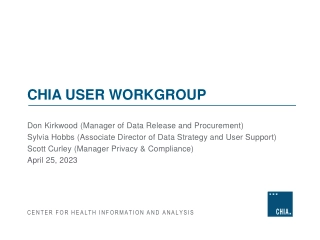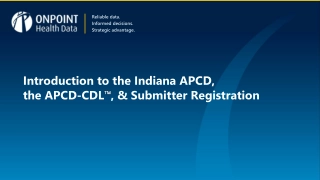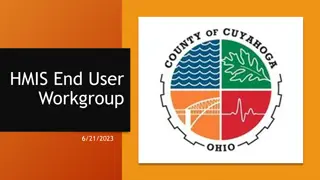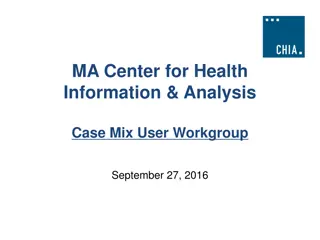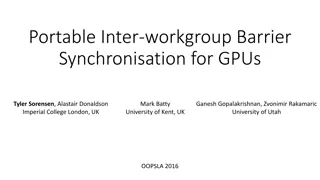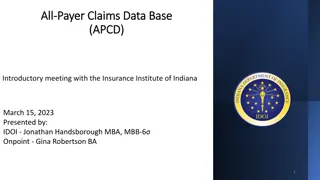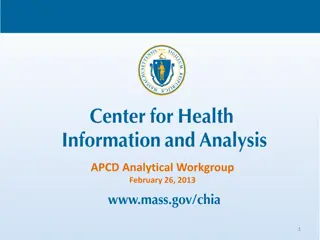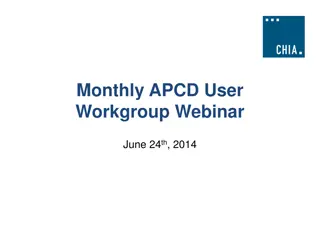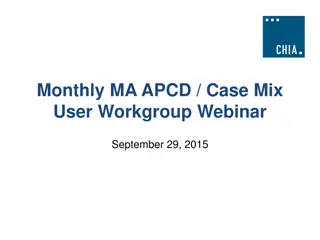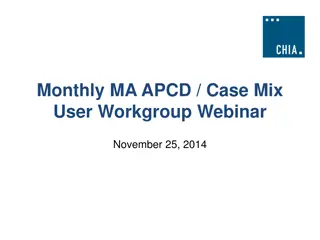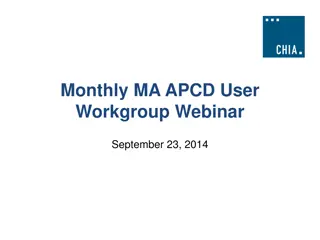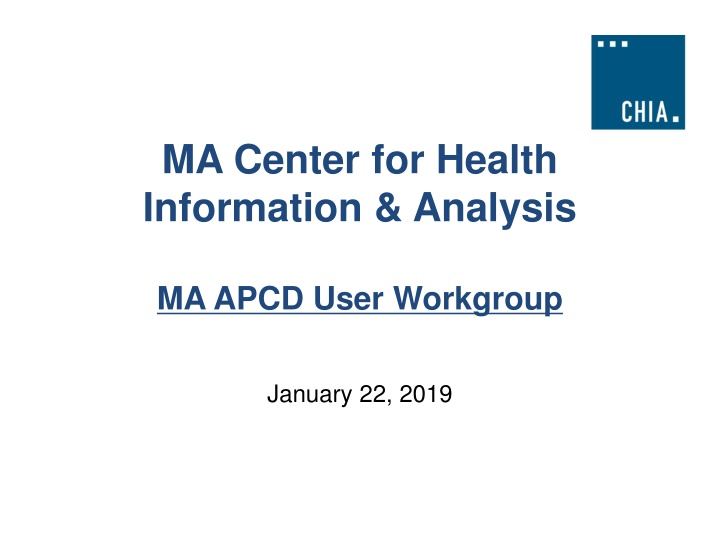
MA Center for Health Information & Analysis: Release 7.0 Updates
Stay informed with the latest updates regarding MA APCD Release 7.0, covering data from January 2013 to December 2017. Explore details on carrier highlights, ICD-10-CM codes, Member Eligibility data, and more. Apply now for access to the updated documentation and specifications.
Download Presentation

Please find below an Image/Link to download the presentation.
The content on the website is provided AS IS for your information and personal use only. It may not be sold, licensed, or shared on other websites without obtaining consent from the author. If you encounter any issues during the download, it is possible that the publisher has removed the file from their server.
You are allowed to download the files provided on this website for personal or commercial use, subject to the condition that they are used lawfully. All files are the property of their respective owners.
The content on the website is provided AS IS for your information and personal use only. It may not be sold, licensed, or shared on other websites without obtaining consent from the author.
E N D
Presentation Transcript
MA Center for Health Information & Analysis MA APCD User Workgroup January 22, 2019
Agenda Announcements / Updates: o MA APCD Release 7.0 o FY17 Case Mix User Support Slide Topics: o Pharmacy Claims Quantity Dispensed o Medical Claims Injury Intent o Member Eligibility Coverage Flags o MA APCD Release 7 Calendar Year 2017 Payer Concentration Ratios Q&A
MA APCD Release 7.0 Available NOW Encompasses data from January 2013 December 2017 with six months of claim runout (includes paid claims through 6/30/18) Release Documentation and Data Specifications have been posted to the website: http://www.chiamass.gov/ma-apcd/ Apply now by listing 2017 (and any other years you want from Release 7.0) in the Years Requested section of the current application form Available here: http://www.chiamass.gov/application-documents
Release 7.0 Highlights Contains ICD-10-CM procedure and diagnosis codes. ICD indicator flag indicates whether codes are reported in ICD-9 or ICD-10 format. o NOTE: the ICD indicator flag is as reported by carriers and is not 100% accurate. Accountable Care Partnership Plans will be denoted starting in 2018 as follows: o Insurance Type Code/Product (ME003, MC003, PC003, DC003) use the new value of 30 to denote ACO. A subset of MassHealth Enhanced Eligibility (MHEE LDS) data is now available to all approved recipients of MassHealth data for the first time. The MHEE LDS data provides a view of a member on any given day.
More Release 7.0 Highlights Updated Master Patient Index A small percentage of records may not have a MEMBERLINKEID due to inconsistencies and inaccuracies in carrier reporting. Please see the MA APCD Release 7.0 Master Patient Index (MPI) Data Exclusion document for a complete list. Created a MEMBERLINKEID crosswalk to enable users to apply Release 7.0 IDs to prior Release 6.0. This is available upon request.
Release 7.0 Carrier Highlights As a result of the Supreme Court Gobeille ruling, several carriers have removed some or all self-insured data from their MA APCD data submissions, resulting in a drop in members and claims in 2016 onward. At the end of 2017 reporting period, approximately 75% (or about 1.75 million members) of self-insured Member Eligibility data is missing from the MA APCD. Several carriers actively poll their employer groups for inclusion in MA APCD. Several small carriers have stopped submitting due to the Supreme Court Gobeille decision or have otherwise left the MA market. CHIA has retained their data for earlier years but users should note that data will be sporadic for the year they exited the MA APCD (consult the Release 7.0 Documentation Guide for full list of payers affected).
Release 7.0 Carrier Highlights Several carriers resubmitted data, improving data linkage between their file types. Three new submitters are included in Release 7.0. Additional carrier-specific highlights (by OrgID) can be found in the Release 7.0 Release Notes: http://www.chiamass.gov/assets/docs/p/apcd/apcd-7.0/MA- APCD-Release-7.0-Release-Notes.pdf
Case Mix FY17 Release Calendar *CURRENT* RELEASE TIMEFRAMES FOR EACH FILE: Inpatient (HIDD) JUNE [COMPLETED] Emergency Department (ED) NOVEMBER [COMPLETED] Outpatient Observation (OOD) JANUARY
Question: I have a couple of questions regarding the pharmacy data. The Quantity dispensed field contains some very large numbers. What do they mean? What are the units? Is there any relationship between Drug units of Measure field and Quantity Dispensed field? Answer: Yes, there is a relationship between Quantity Dispensed and Drug Units of Measure and also Days Supply. Different Drug Units of Measure and Days Supply impact the value of Quantity Dispensed. Quantity Dispensed is defined as the number of metric units of medication dispensed. Days Supply are the number of days the prescription will last if taken as prescribed. Drug Units of Measure are the units of measure for drug dispensed using the following values: Code Description EA Each F2 International Units GM Grams ML Milliliters MG Milligram MEQ Milliequivalent MM Millimeter UG Microgram UU Unit Quantity Dispensed, the Drug Units of Measure, and Days Supply can in combination be used to calculate dosage. Dosage Calculation Example If a 15-day supply consists of 30 pills at 200 mg per pill, then the daily dose would be 400 mg/day according to the following formula: QUANTITY DISPENSED EXAMPLES QUANTITY DISPENSED of ORALYTE ELECTROLYTE is 15,000 for 30 days, where DRUGUNITOFMEASURE= ML (e.g. Liquid) QUANTITY DISPENSED of PREDNISONE is 810 for 90 days, where DRUG UNIT OF MEASURE= EA (e.g. Tablet) Daily Dose = (# Units Dispensed * Strength per Unit) / (Days Supplied)
Question: I have a couple of questions regarding the pharmacy data. The Quantity dispensed field contains some very large numbers. What do they mean? What are the units? Is there any relationship between Drug units of Measure field and Quantity Dispensed field? (continued) Answer: For Drug Units of Measure, to illustrate the variation in metric units other than weight that measure drug properties, the Massachusetts Department of Public Health provides to pharmacists the following three examples: Drug Units of Measure Examples Each is used when referring to the following dosage forms: capsule, diaphragm, disc, patch, plaster, suppository, suture, tablet, troche, and wafer. ML is used when referring to the following dosage forms: aerosol liquids (note: some formulations are powders, use gm ), elixirs, emulsions, extracts, mouthwash, oils, shampoos, liquid soaps, solutions, sprays, suspensions, syrups, tinctures. For example: A pharmacist dispensed 1 package of 10 morphine sulfate syringes, each syringe containing 2 mL of 10 mg/mL morphine. The total volume dispensed is 20 mL and the Quantity Dispensed reported will be 20 . GM is used when referring to the following dosage forms: aerosol powders (note: some formulations are liquids, use mL ), creams, crystals, gels, jellies, granules, ointments, powders.
Question: I have historically used Case Mix data for injury surveillance due to high quality E-Codes. Beginning in summer of 2017, Massachusetts (MA) suicide deaths increased. With the transition to ICD-10-CM, did injury intent data in the MA APCD improve in a way that would allow us to characterize injury risks? Answer: In evaluating MA APCD Release 7.0 suicide attempt coding at the implementation of ICD-10-CM in October 2015 and comparing a count of distinct MA residents seeking care in any setting for attempted suicide (see Fig. 1) to the CDC count of MA suicide deaths (see Fig. 2), an MA APCD increase in those seeking care for attempted suicide in the latter part of 2017 mirrored the increase in suicide deaths reported by CDC. The value to risk assessment is that the MA APCD moving trend line reveals a 2017 surge in suicide ideators one month prior to the surge in actual suicide deaths. Figure 1. Oct 2015 through 2017 MA APCD Count of Distinct MA Residents receiving care for Attempted Suicide 575 500 425 350 275 200 Figure 2. Oct 2015 to Dec 2017 Centers for Disease Control and Prevention Count of Suicide Deaths by MA Residents * 80 70 60 50 40 30 20 *Source: Centers for Disease Control and Prevention, National Center for Health Statistics. Underlying Cause of Death 1999-2017 on CDC WONDER Database, released December, 2018. Data are from the Multiple Cause of Death Files, 1999-2017, as compiled from data provided by the 57 vital statistics jurisdictions through the Vital Statistics Cooperative Program.
Question: The Member Eligibility file contains several benefit flag fields for evaluating specific types of coverage. What is the percentage of reporting volume? How complete is the data? Answer: MA APCD filing specifications have an expected 100% reporting threshold for Medical Coverage, Prescription Drug Coverage, Dental Coverage, Behavioral Health Benefit, Laboratory Benefit, and Disease Management fields. The tables below show that APCD Release 7.0 coverage fields have a high level of completeness and low percent of blanks. Frequency of Member Eligibility Benefit Coverage Flag Fields in MA APCD Release 7 Medical Coverage (ME018) Yes No Unknown Not Applicable Blank TOTAL Total Flags 203,568,878 84,544,477 11,505,016 49,956,576 17,102,010 366,676,957 Flag Frequency 55.5% 23.1% 3.1% 13.6% 4.7% 100% Behavioral Health (ME051) Yes No Unknown Not Applicable Blank TOTAL Total Flags 203,128,604 41,520,762 17,560,550 104,467,027 14 366,676,957 Flag Frequency 55.4% 11.3% 4.8% 28.5% 0.0% 100% Dental Coverage (ME020) Yes No Unknown Not Applicable Blank TOTAL Total Flags 90,854,759 172,792,319 30,513,031 72,516,834 14 366,676,957 Flag Frequency 24.8% 47.1% 8.3% 19.8% 0.0% 100% Laboratory Benefit (ME052) Yes No Unknown Not Applicable Blank TOTAL Total Flags 144,913,458 65,740,246 27,242,094 128,781,132 27 366,676,957 Flag Frequency 39.5% 17.9% 7.4% 35.1% 0.0% 100% Drug Coverage (ME019) Yes No Unknown Not Applicable Blank TOTAL Total Flags 211,361,685 79,485,430 3,277,723 72,552,099 20 366,676,957 Flag Frequency 57.6% 21.7% 0.9% 19.8% 0.0% 100% Disease Management (ME53) Yes No Unknown Not Applicable Blank TOTAL Total Flags 2,987,954 85,615,293 168,630,372 109,443,324 14 366,676,957 Flag Frequency 0.8% 23.3% 46.0% 29.8% 0.0% 100%
Question: In the initial release of the MA APCD, payer concentration ratios for calendar year 2011 revealed that over 90 % of paid claims were concentrated among 15 payers. In the newest release of the MA APCD have the concentration ratios changed? Answer: In MA APCD Release 7.0, calendar year 2017 paid claims payer concentration ratios by claims file type still reveal 90% of paid claims concentrated among 15 payers. There has however been an increase in top 5 payer concentration for medical claims from 71% of payers in 2011 to 76.7% in 2017, for dental claims from 83.2% to 87%, with a decrease in top 5 concentration for pharmacy claims from 60% to 55.9%. Concentration Ratios by Calendar Year 2017 Paid Claims ($) Payer Concentration Top 5 Payers Top 10 Payers Top 15 Payers Top 20 Payers Top 25 Payers Medical Pharmacy 76.7% 89.4% 95.0% 97.8% 98.9% Dental 87.0% 95.6% 98.4% 99.3% 99.7% 55.9% 77.5% 90.6% 95.9% 98.3% Number of Additional Payers 28 17 11 Total Payers by File 53 42 36
Where can I find old User Workgroup presentations? http://www.chiamass.gov/ma-apcd-and-case-mix-user-workgroup-information/
Questions? Questions related to MA APCD: (apcd.data@state.ma.us) Questions related to Case Mix: (casemix.data@state.ma.us) REMINDER: Please include your IRBNet ID#, if you currently have a project using CHIA data
Call for Topics and Presenters If there is a TOPIC that you would like to see discussed at an MA APCD or Case Mix workgroup in 2018, contact Adam Tapply [adam.tapply@state.ma.us] If you are interested in PRESENTING at an MA APCD or Case Mix workgroup in 2018, contact Adam Tapply [adam.tapply@state.ma.us] You can present remotely from your own office, or in-person at CHIA.

